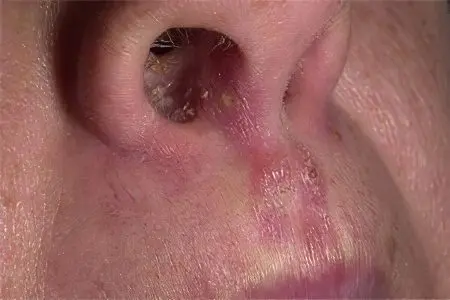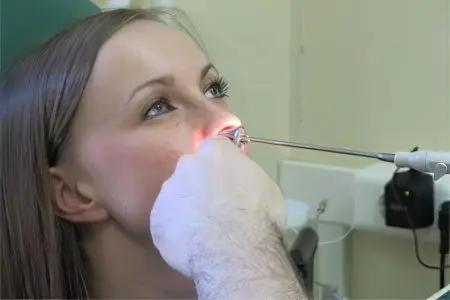Contents

Staphylococcus in the nose is the presence of bacteria in the nasal mucosa that can cause a purulent-inflammatory disease. There are more than 20 varieties of staphylococcus, and most of them are constant companions of a person and are normally present on the mucous membranes, including the nose. At the same time, they do not cause an inflammatory process.
However, among all varieties, there are several pathogenic bacteria, the most dangerous of which is Staphylococcus aureus. Normally, it should not be in the body. Once inside, including on the nasal mucosa, staphylococcus begins to actively multiply, poisoning the human body with its toxins and causing an inflammatory process.
In addition to Staphylococcus aureus, inflammatory processes in the nasal cavity can cause epidermal and hemolytic staphylococci.
According to statistics, up to 20% of the adult population are permanent carriers of staphylococcus in the nose, while in 60% of people it lives in the nasopharynx periodically, and only in 5% of people the nasal mucosa is not populated by these bacteria, thanks to excellent local immunity.
Symptoms of staphylococcus in the nose
In some cases, a person may not be aware that one or another type of staphylococcus lives in his nose. This is an asymptomatic carrier. But in the presence of a number of favorable factors, for example, with a decrease in immune forces, with an exacerbation of chronic diseases, with hypothermia, with nasal injuries and for other reasons, the bacterium begins to actively grow and multiply. In some people, pathogenic staphylococcus, immediately after contact with the nasal mucosa, causes inflammation.
This leads to the appearance of a characteristic clinical picture:
The appearance of a runny nose, which in medicine is called rhinitis.
An increase in the mucous secretion, which is initially transparent, but after a short time, impurities of pus are found in it.
Difficulty breathing, which is associated with blockage of the nasal passages.
Violations of the sense of smell, the inability to fully sense the smells.
Change in the timbre of the voice, its nasality and hoarseness.
Breathing through the mouth, which is fraught with the development of complications in the form of inflammation of the larynx, trachea and bronchi.
An increase in body temperature, with acute rhinitis, it can reach 38 ° C. With the development of complications – 39 ° C and more.
Violations of night rest, difficulty falling asleep, general fatigue and malaise.
Often, staphylococcus, in addition to the nasal cavity, inhabits the paranasal sinuses, provoking the development of sinusitis or frontal sinusitis.
Children may experience a rash on the body.
How is staphylococcus transmitted in the nose?

To avoid infection, it is worth knowing how the bacterium can enter the nasal cavity.
Among the most common methods of transmission, doctors have identified the following:
Airborne route. That is, a person inhales air that is infected with staphylococcus aureus and they naturally enter the cavity of his nose, resulting in infection. They are released into the environment by their carriers when sneezing, coughing and talking. In addition, pets can serve as a source.
The period of intrauterine development, the process of delivery and breastfeeding. Diseases of children with staphylococcal infection are almost always associated with the fact that their mother is infected. The fetus can become infected by the hematogenous route, as well as with placenta adherence and other violations of labor activity.
Air-dust path. This route of infection is closely related to the airborne route. That is, when an infected organism releases bacteria into the environment, they, in turn, do not immediately fall on the nasal mucosa, but settle in the dust. A healthy person becomes infected when this dust is inhaled.
Contact-household route of infection. When infection occurs as a result of using someone else’s personal care products or through close contact, such as kissing or just by touching the skin.
Infection in a hospital.
In addition, there are additional risks that contribute to the fact that the bacterium enters the nasal cavity and begins to multiply actively there:
Hypothermia is one of the leading provoking factors of inflammation. This is due to the fact that when a person inhales cold air, the cilia of the ciliated epithelium, which are responsible for cleansing the nasal cavity, cease to move actively. As a result, pathogenic microbes settle in the mucosa for a long time and begin to multiply actively there.
SARS and influenza no less often lead to the development of staphylococcal rhinitis. Against the background of these diseases, not only local, but also general immunity is reduced. Therefore, often the infection awakens during an acute respiratory illness.
Prolonged use of drops that have the property of constricting blood vessels leads to the fact that a person begins to suffer from drug-induced rhinitis. Against this background, it is much easier for staphylococcus to penetrate the nasal cavity and begin to multiply.
The state of health and age of a person. There are certain groups of people who are most susceptible to staph infection. These groups include children under one year old, newborns, the elderly and people with serious chronic diseases.
The body’s susceptibility to bacteria increases due to long-term use of medications, such as cytostatics and corticosteroids.
Exacerbation of chronic foci of infection – tonsillitis, adenoiditis, pharyngitis.
Severe and prolonged stress.
Why is staphylococcus in the nose dangerous?

The danger that an inflammatory reaction occurs in the nose caused by a staphylococcal infection lies in the possibility of a rapid spread of the process not only to the respiratory tract, but also to neighboring organs. That is, not only the nearby sinuses, trachea, larynx or tonsils can suffer. By hematogenous or lymphogenous route, the bacterium is able to reach the lungs, liver, heart, etc.
The following clinical picture is often observed: a patient who suffered only from a runny nose, after a few days, if untreated, begins to notice signs of otitis media, tonsillitis, sinusitis, adenoiditis, etc. In addition, in a certain category of people who have a predisposition, the bacterium in within a few days can cause bronchitis and tracheitis. And the beginning is, it would seem, banal acute rhinitis.
A staph infection in the nose is extremely dangerous for children and the elderly. In them, the bacterium is capable of provoking not only bronchitis and tracheitis, but also abscesses, massive lesions of the lungs, bones, brain, kidneys and heart. In the most severe cases, the presence of staph in the nose can lead to septic infection of the blood.
That is why the detection of staphylococcal infection in newborn children is the reason for inpatient treatment.
Staphylococcus aureus in the nose
It is the mucous membrane of the nasal cavity that is the favorite place for the settlement of Staphylococcus aureus. Often it asymptomatically exists there for a long time, but in the presence of factors such as: hypothermia, infection with SARS, use of vasoconstrictor drops for a long time, it begins to multiply actively, causing acute rhinitis.
In the future, acute rhinitis causes serious complications, which were described above. Another danger of Staphylococcus aureus lies in its low susceptibility to penicillin preparations. That is, in order to select adequate therapy, it is necessary to conduct an antibiogram.
Diagnostics
Before proceeding with treatment, it is necessary to conduct a qualitative diagnosis. The main analysis that is used in medical practice when a pathogenic bacterium is suspected is their isolation by bacterial culture. However, the patient will need to prepare for the study in order to obtain the most reliable result.
First, on this day, you should stop using any nasal drops. Secondly, do not undergo treatment with any antibacterial agents for at least a week. The only drawback of this method is that the result will have to wait at least five days.
If the diagnosis needs to be made faster, then the microscopic method of smear analysis comes to the rescue. But unlike it, the cultural method of research, namely, bakposev, will allow not only to clarify the data obtained, but also to identify a specific type of bacterium, as well as to supplement the information with an antibiogram.
After the results are obtained and staphylococci in the nose were detected in an amount exceeding the maximum mark of 106 units, it is necessary to start treatment.
Treatment of staphylococcus in the nose

The leading drug to neutralize staphylococcus aureus is antibiotics. The scheme of their reception is determined in each case individually, as well as the selection of the remedy itself.
Most often, when an infectious process is detected in the nose, the patient is prescribed the drug in tablet form. Although injections may be required in some cases:
For the treatment of non-Staphylococcus aureus in the nose, antibacterial drugs of the penicillin series are used.
If the presence of Staphylococcus aureus is detected, then it is advisable to prescribe combined agents.
If the pathological process in the nose cannot be corrected with antibiotics (or their administration is impossible) and threatens the development of serious complications, then treatment is prescribed using antistaphylococcal immunoglobulin or toxoid. These funds allow you to remove intoxication. In addition, it is advisable to take antistaphylococcal bacteriophages.
In addition to the above remedies, the doctor may prescribe:
immunomodulators, which are designed to increase the overall resistance of the body;
anti-allergic agents designed to relieve puffiness;
vitamin-mineral complexes.
To increase the therapeutic effect, the patient needs to use antiseptics for local treatment. To prevent infection of the tonsils, the throat should also be gargled with antiseptics.
If there are large abscesses on the skin around the nose, then the question of their opening is taken by the doctor. For this, the patient is sent to the surgical room.
We should not forget about preventive measures that are aimed at preventing infection or curbing the pathological growth and development of bacteria in the nose. First of all, it is the observance of the rules of personal hygiene and the maintenance of the immune forces of the body by all known methods (refusal of bad habits, rational nutrition and physical activity).









